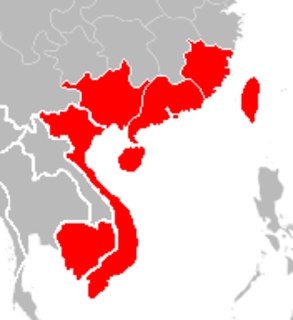
Geminiviridae is a family of plant viruses that encode their genetic information on a circular genome of single-stranded (ss) DNA. There are currently 485 species in this family, divided among 9 genera. Diseases associated with this family include: bright yellow mosaic, yellow mosaic, yellow mottle, leaf curling, stunting, streaks, reduced yields. They have single-stranded circular DNA genomes encoding genes that diverge in both directions from a virion strand origin of replication. According to the Baltimore classification they are considered class II viruses. It is the largest known family of single stranded DNA viruses.

Potyviridae is a family of positive-strand RNA viruses that encompasses more than 30% of known plant viruses, many of which are of great agricultural significance. Currently, 228 species are placed in this family, divided among 12 genera with three unassigned species.

Potyvirus is a genus of viruses in the family Potyviridae. Plants serve as natural hosts. There are currently 183 species in this genus including the type species Potato virus Y. The genus is named after the type virus. Potyviruses account for ~30% of the currently known plant viruses. Like begomoviruses, members of this genus may cause significant losses in agricultural, pastoral, horticultural and ornamental crops. More than 200 species of aphids spread potyviruses and most are from the subfamily Aphidinae.

Carmovirus is a genus of viruses, in the family Tombusviridae. Plants serve as natural hosts. There are currently 19 species in this genus including the type species Carnation mottle virus. It is classified under the Baltimore classification system as a group IV virus, having a single-stranded, positive-sense RNA genome.
Bean yellow mosaic virus is a plant pathogenic virus in the genus Potyvirus and the virus family Potyviridae. Like other members of the Potyvirus genus, it is a monopartite strand of positive-sense, single-stranded RNA surrounded by a capsid made for a single viral encoded protein. The virus is a filamentous particle that measures about 750 nm in length. This virus is transmitted by species of aphids and by mechanical inoculation.
Bidens mottle virus (BiMoV) is a pathogenic plant virus in the plant virus family Potyviridae. BiMoV is a flexuous filamentous particle, 720 nm long, and belongs to the Potyviridae genus Potyvirus. Like other viruses in this genus, Bidens mottle virus is transmitted both mechanically by sap and by aphids in a stylet-borne fashion.

Benyvirus is a genus of viruses, in the family Benyviridae. Plant serve as natural hosts. There are currently four species in this genus including the type species Beet necrotic yellow vein virus. Diseases associated with this genus include: BNYVV: rhizomania.
Carlavirus, formerly known as the "Carnation latent virus group", is a genus of viruses in the order Tymovirales, in the family Betaflexiviridae. Plants serve as natural hosts. There are currently 53 species in this genus including the type species Carnation latent virus. Diseases associated with this genus include: mosaic and ringspot symptoms.
Commelina mosaic virus (CoMV) is a plant pathogenic virus in the genus Potyvirus and the virus family Potyviridae. Like other members of the Potyvirus genus, CoMV is a monopartite strand of positive-sense, single-stranded RNA surrounded by a capsid made for a single viral encoded protein. The virus is a filamentous particle that measures about 707-808 nm in length. This virus is transmitted by two species of aphids, Myzus persicae and Aphis gossypii, and by mechanical inoculation.
Clover yellow vein virus (ClYVV) is a plant pathogenic virus in the genus Potyvirus and the virus family Potyviridae. Like other members of the Potyvirus genus, ClYVV is a monopartite strand of positive-sense, single-stranded RNA surrounded by a capsid made for a single viral encoded protein. The virus is a filamentous particle that measures about 760 nm in length. This virus is transmitted by several species of aphids in a nonpersistent manner and by mechanical inoculation.
Ipomovirus is a genus of viruses, in the family Potyviridae. There are currently seven species in this genus including the type species Sweet potato mild mottle virus. They infect plants and are transmitted by whiteflies. The name of the genus is derived from Ipomoea - the generic name of sweet potato.
Macluravirus is a genus of viruses, in the family Potyviridae. Plants serve as natural hosts. There are currently ten species in this genus including the type species Maclura mosaic virus.
Narcissus degeneration virus (NDV) is a plant pathogenic Potyvirus of the family Potyviridae which infects plants of the genus Narcissus. It is one of the most serious and prevalent of the approximately 21 viruses which infect this genus.NDV is associated with chlorotic leaf striping in N. tazetta.
Narcissus late season yellows virus (NLSYV) is a plant pathogenic Potyvirus of the family Potyviridae which infects plants of the genus Narcissus. It was originally isolated from N. pseudonarcissus in 1977.
Broad bean wilt virus 1 (BBWVI) is a plant pathogenic virus of the order Picornavirales, family Secoviridae, subfamily Comovirinae, genus Fabavirus.
Narcissus tip necrosis virus (NTNV) is a plant pathogenic virus of the family Tombusviridae, which infects plants of the genus Narcissus, the only known host.
''Narcissus white streak virus (NWSV) is a plant pathogen of the family Potyviridae which infects plants of the genus Narcissus, and is transmitted by aphids. It is among the commonest and most serious of the viral infections that infect narcissi, but appears to be confined to N. tazetta.
Tungrovirus is a genus of viruses, in the family Caulimoviridae order Ortervirales. Monocots and family Poaceae serve as natural hosts. There is currently only one species in this genus: the type species Rice tungro bacilliform virus. Diseases associated with this genus include: stunting, yellow to orange leaf discoloration with fewer tillers. Tungro means 'degenerated growth' in a Filipino dialect and the virus was first observed in the Philippines 1975.

Longan witches broom-associated virus is a species of positive-sense single-stranded RNA virus that has not been assigned to a genus within the family Potyviridae. It is thought to be the cause of witch's broom in longan, a large tropical tree from southeastern Asia of economic value. Longan witches broom disease is a condition that was first described in 1941. The virus was found in symptomatic plants and absent in healthy plants, but not all of Koch's postulates have been fulfilled.

Botourmiaviridae is a family of positive-strand RNA viruses which infect plants and fungi. The family includes four genera: Ourmiavirus, Botoulivirus, Magoulivirus and Scleroulivirus. Members of genus Ourmiavirus infect plants and the other genera infect fungi. The member viruses have genomes which range from 2900 to 4800 nucleotides.





